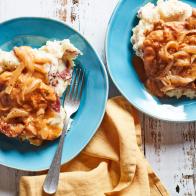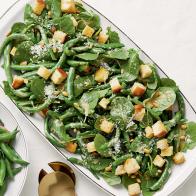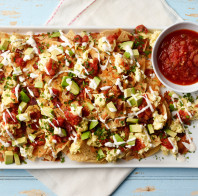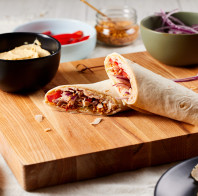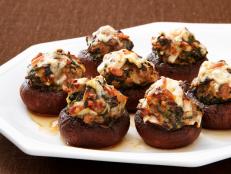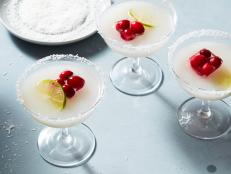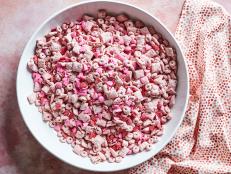21 Recipes for a Lunar New Year Celebration
Whether you cook traditional dishes that symbolize wealth and longevity or gather around the table with modern takes on the classics, these Lunar New Year recipes are sure to make your meal one to remember.
Related To:
Photo By: Teri Lyn Fisher
Photo By: Teri Lyn Fisher
Photo By: Teri Lyn Fisher
Photo By: Chantell Quernemoen
Photo By: Teri Lyn Fisher
Photo By: Tara Donne ©FOOD NETWORK : 2012, Television Food Network, G.P.
Photo By: Teri Lyn Fisher
Photo By: Matt Armendariz
Photo By: Eric Wolfinger
Photo By: Teri Lyn Fisher
Photo By: Teri Lyn Fisher
Photo By: Chantell Quernemoen
Photo By: Chantell Quernemoen
Photo By: Chantell Quernemoen
Time to Celebrate
Lunar New Year, also called Spring Festival, is a time for friends and families to gather, feast and wish for a prosperous new year. The foods you’ll find on the table during this festive season are deeply symbolic and meant to celebrate togetherness and signify wealth and good fortune. The dishes range from savory preparations like noodles, dumplings and whole fish to sweet treats — like these tangyuan (or, chewy rice balls). Tangyuan are traditionally eaten as a dessert during the family reunion dinner on Chinese New Year's Eve. Each bowl of tangyuan symbolizes unity; and the smoothness of each ball represents how smooth the family's year will be. The rice balls have a soft and slightly bouncy texture and a sweet surprise in the center. The traditional filling for tangyuan is made with black sesame seeds, but we chose a less typical version — a sweet, nutty and luscious peanut filling.
Get the Recipe: Tangyuan with Peanut Filling
Steamed Striped Bass with Ginger and Scallions
Steamed fish is one of the most common dishes eaten during Lunar New Year as it symbolizes wealth and prosperity in the coming year. If this is your first time cooking a whole fish, Jet’s recipe makes it easy. He pours a simple sauce (made with just a few ingredients) over the fish before baking so you’re guaranteed a savory, flavorful finish.
Get the Recipe: Steamed Striped Bass with Ginger and Scallions
Dumplings with a Crispy Skirt
Dumplings with a crispy skirt are essentially pan-fried dumplings with a thin and crisp outer layer (the "skirt") for an added texture. They're popular at izakayas throughout Japan, where they're called hanetsuki gyoza ("gyoza with wings") and at Chinese dumpling shops, where they're sometimes called binghua jianjiao ("ice-flower fried dumplings"). In this recipe, we developed a foolproof method for the skirt. Typically, it's made from a slurry of just flour and water but if the ratio is off, it can result in a thick skirt that is gummy. We added cornstarch and vinegar to the slurry to help prevent gluten from forming, resulting in a super thin and crisp skirt.
Get the Recipe: Dumplings with a Crispy Skirt
Ba Bao Fan
Served during weddings, Lunar New Year and other celebrations, the Chinese dessert known as "eight treasure rice" is made with eight different fruits, nuts and seeds. It’s said to be auspicious because the pronunciation of "eight" in Chinese is close to the pronunciation of the Chinese word for luck or fortune. Although the dessert is brushed with sugar syrup before serving, it’s not very sweet. Our recipe includes extra sugar syrup to serve on the side for those who want to bump up the sweetness. Feel free to substitute other fruits, nuts and seeds.
Get the Recipe: Ba Bao Fan
Chinese Almond Cookies
Almond cookies like these are thought to resemble coins, making them particularly popular as a symbol of good fortune during the Chinese New Year. Traditional recipes are made with lard and flavored with almond extract. We used butter and almond flour in these to boost the nutty flavor and create a crumbly texture similar to pecan sandies. Enjoy them year-round, particularly with a cup of tea or coffee.
Get the Recipe: Chinese Almond Cookies
Carrot Steamed Buns
Molly’s steamed carrot buns are a wonderful addition to any Lunar New Year meal. They take a bit of planning (the dough needs to rise) but you can save some time if you make the filling a day in advance. Just be sure to store it in the refrigerator until you’re ready to fill and steam the buns.
Get the Recipe: Carrot Steamed Buns
Crispy Stuffed Lotus Root with Pork
Lotus root is prized for its characteristic texture, which is similar to water chestnuts. Even after stir-frying, frying, boiling, braising or steaming, it remains crisp and tender. This traditional dish is made during Chinese New Year — in Cantonese, lotus root ("leen ngau") is directly translated to "year have," meaning you should have another year to come — and is a beautiful harmony of crunchy coating, crisp lotus root and savory (and juicy) pork filling.
Get the Recipe: Crispy Stuffed Lotus Root with Pork
Mushroom and Leek Spring Rolls
Spring rolls are a Lunar New Year favorite. They look like gold bars — so they are a symbol of wealth and prosperity. Ming fills his with three types of mushrooms, leeks and a flavorful blend of ginger, garlic and serrano chiles before deep frying each one to the perfect, rich golden color.
Get the Recipe: Mushroom and Leek Spring Rolls
Longevity Noodles
Noodles are a part of many celebratory Chinese meals, Lunar New Year included. Not only do these yi mein symbolize long life, but eating them is believed to bring prosperity and luck.
Get the Recipe: Longevity Noodles
Chicken Pot Stickers with Dipping Sauce
Dumplings are delicious any time of year, any way you make them — Lunar New Year included. The wonderful thing about enjoying them during the holiday is that they make a great family project. Gather everyone together to fill and fold the dumplings. Then cook and eat!
Get the Recipe: Chicken Pot Stickers with Dipping Sauce
Taiwanese Pineapple Cakes
Tender, buttery dough wraps around sweet, sticky pineapple filling in these tasty Taiwanese cakes often gifted and enjoyed during the Lunar New Year, but also found year-round. The filling is made from crushed pineapple that's cooked down with sugar until thick and jammy. The shortbread-like dough is then wrapped tightly around the filling and pressed into traditional molds, then baked until just golden.
Get the Recipe: Taiwanese Pineapple Cakes
Steamed Pork-and-Mushroom Shumai
Don’t let their small size fool you. These steamed dumplings have big flavor, thanks to ingredients like ginger, soy sauce, and toasted sesame oil. A simple blend of chile paste and soy sauce make a delicious sauce for dipping — and the perfect finishing touch.
Get the Recipe: Steamed Pork-and-Mushroom Shumai
Bai Qie Ji (White Cut Chicken)
In Cantonese families, bai qie ji is typically made for Chinese New Year reunion dinner because it is simple to cook, results in succulent chicken and pairs well with the other dishes in the holiday dinner. Bai qie ji is usually paired with a soy sauce dipping sauce when made at home, but we've paired ours with a scallion-ginger sauce, a typical accompaniment in restaurants.
Get the Recipe: Bai Qie Ji (White Cut Chicken)
Scallion-Ginger Sauce
Scallion-ginger sauce is usually served alongside soy sauce chicken, bai qie ji (white cut chicken) and roasted meats with rice (commonly called rice boxes) in restaurants in Chinatowns around the country. There are many methods for making it, from a no-cook version (which results in a very green sauce with a sharp scallion and ginger flavor) to a browned version (which results in a beautiful flavor but less appealing color). Our combination method produces a happy medium. The hot oil brings out the vibrant green of the scallions and mellows the sharpness of the scallions and ginger.
Get the Recipe: Scallion-Ginger Sauce
Chocolate Sesame Balls
A nod to the sweet, filled rice balls eaten during the Spring Festival, these sesame-coated sweets have a delicious surprise inside — a dollop of chocolate-hazelnut spread.
Get the Recipe: Chocolate Sesame Balls
Pan-Fried "Turnip" Cake (Law Bak Go)
These turnip cakes are a great addition to any Lunar New Year celebration. Food Network Kitchen staffer Vivian Chan remembers making about 30 every year with her mom, some to gift to friends and family and a couple to enjoy at home on New Year morning.
Get the Recipe: Law Bak Go
Pork Soup Dumplings
Molly says, "Xiao long bao, or soup dumplings, are Chinese steamed dumplings that have soup inside of them. They are like magic! I grew up eating these with my family at our favorite dim sum restaurant in Chicago's Chinatown and later learned how to make them by combining my family's go-to pot sticker recipe with the secret ingredient: soup gelatin, which melts down into soup once the dumplings are cooked."
Get the Recipe: Pork Soup Dumplings
Fortune Cookies
There’s no better way to start a new year than by spreading warm wishes to the ones you hold near and dear. That’s why we love the idea of homemade fortune cookies. Your friends and family will love cracking the cookies open to find a hand-written note, wishing them a prosperous new year.
Get the Recipe: Fortune Cookies
Ginger-Glazed Salmon
Molly’s spin on serving fish for Chinese New Year has a sweet touch — she glazes the salmon with maple syrup because it’s one of her dad’s favorite flavors.
Get the Recipe: Ginger-Glazed Salmon
Fa Gao
Fa Gao, or fortune cake, is a popular Chinese dessert typically eaten during the Lunar New Year to bring luck and money in the coming months. The chewy and lightly sweetened steamed cakes were traditionally leavened with yeast, which helps create the signature cracked flower-like design on top. However, nowadays bakeries often substitute double-acting baking powder; it yields the same effect in far less time. The key to the recipe is to make sure the water is at a rolling boil and generating lots of steam when you cook the cakes. That high heat works with the leavening agent to form the cracks.
Get the Recipe: Fa Gao
Hong Dou Tang
Sweet red bean soup is a dessert fixture at Chinese banquets and during the Lunar New Year, when many households also enjoy it as a light snack. It may owe part of its popularity to the fact that in Chinese culture red beans are said to provide strength because of their color (red symbolizes power) and the amount of protein they contain. The soup, which contains chewy small tapioca pearls, is typically thin. We wanted a heartier version, so developed this recipe accordingly. You can always thin it with some water, if you prefer. It’s also lightly sweetened, so feel free to add more sugar.
Get the Recipe: Hong Dou Tang

